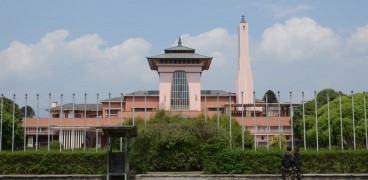Sagarmatha National Park, located in the Solukhumbu district of Nepal, is best known as the country's first-ever national park to be listed as a Natural World Heritage. The conservation area located amidst the Himalayas is best known as the home of the world's highest mountain peak, Mt. Everest (8,848 m).
The wildlife sanctuary is home to 118 species and mammals which live in the hills and mountain peaks whose elevation ranges between 2,845 to 8,848 m. Sagarmatha National Park is identified as an Important Bird Area (IBA) by the BirdLife International.
Where is the Sagarmatha National Park?
Established on 19th July 1976, Sagarmatha National Park lies in the eastern region of Nepal. The conservation area shares its northern border with Tibetan national park, Qomolangma National Nature Preserve.

Sagarmatha: Majestic Mountain Panorama
Credit:national-park.org
In the east, it lies adjacent to the Makalu Barun National Park whereas in the south it extends over to the Dudh Koshi river.
The wildlife sanctuary covers an area of 1,148 km square (443 sq mi). In January of 2002, a Buffer zone covering an area of 275 square km was added to the protected area.
Meaning of Sagarmatha
The name Sagarmatha is derived from the Nepali word Sagar which mean sky while Matha means head. It is home to the Mt. Everest which is also known as Sagarmatha or Chomolungma.
How to reach the Sagarmatha National Park?
The Natural World Heritage Site can be entered from its southern entrance, Monzo (2,385 m) which lies a day away from the Tenzing Norgay Airport in Lukla (2,860 m).
Habitants of Sagarmatha National Park
The Sagarmatha National Park is home to over more than 6,000 Sherpas who dwell in over 20 villages found in the region.
Amongst them, the most famous village is Namche Bazaar (3,440 m) which serves as a stop for tourists trekking towards the Everest Base Camp (5,364 m) or climbing Mt. Everest.

Sagarmatha: Everest's Breathtaking Beauty
Credit:national-park.org
The Sherpas are believed to have been residing here since the last four centuries. They follow a traditional practice of their culture and religion and have restricted the slaughter and hunting of the living being found around the conservational area.
Their traditional beliefs and practices of management of the indigenous natural resources have contributed to the successful conservation of the Sagarmatha National Park.
Wildlife found in Sagarmatha.
The terrains and the mountains in the conservation area range from a height of 2,845 m to 8,848 and are home to several species of animals and birds.
The climatic zones of the area are an alpine zone, subalpine zone, and a temperate forest zone. These climatic zones favour the survival of mammals like Himalayan black bear, red panda, snow leopard, musk deer, Himalayan thars, Himalayan wolves, langur monkeys, martens, etc.
The National Park is also home to over 118 different species of birds like the blood pheasant, Himalayan monal, yellow-billed chough, red-billed chough, and many others.
As the altitude increases, the oxygen level in the area decreases, as a result of which the varied species of the animal kingdom found in these areas are adapted to live with less oxygen and colder temperatures.
The animals found in these areas are covered with thick fur to sustain their body heat.
Tourism of SNP
The conservation area became to the public around the early 1960s. The most popular tourist area in the national park is Namche Bazaar which lies atop a hill.
A company of the Nepali Army is camped in Namche for the protection of Sagarmatha National Park.
According to a report over 3,600 tourists visited the site in 1979 which increased to over 25,000 in 2010. Further studies show that during the fiscal year, 2016-2017, about 45,112 tourists visited the region.
Tourism has helped boost the economy and the living standard of the people, providing them with better education, health, and other infrastructural facilities.
Vegetation in the Sagarmatha National Park
The lower forest region of SNP is best known for trees like rhododendron, juniper, firs, blue pines, bamboo, firs, and birch. Above these forest region lies the zone that is better known for dwarf-sized shrubs.
With the increase in altitude, the vegetation of the conservational gets limited to mosses and lichens. Above 5,750 m the plants cease to grow as the land is covered with thick snow of the Himalayas.

Beautiful mountain range seen from Sagarmatha National Park
The lower elevations of the Sagarmatha National Park is covered with thick, dense forests of hemlock and pines. The forest at around 3,500 m is covered with rhododendron, birch, silver fir, and juniper trees.
About 69% of the conservation area comprises of barren land which lies above the altitude of 5,000m. 28% consists of land consists of grazing pastures, and 3% is covered with thick, dense forests.
Things to do in Sagarmatha National Park:
- Visit Namche Bazaar, the gateway to Mt. Everest.
- Trek to Kala Patthar (5,644.5 m).
- Enjoy the spectacular views of the major mountains in the region like Mt. Everest, Lhotse (8,501 m), Cho Oyu (8,153 m), Nuptse (7,896 m), Amadablam (6,812 m), Thamserku (6,608 m), and many others.
- Enjoy Ice Skating and Figure Skating at the oligotrophic lakes of Gokyo Lakes which lie at the height of 4,500 m - 5,000 m.
- Climb the roof of the world and experience the view from the world highest peak, Mt. Everest.
















